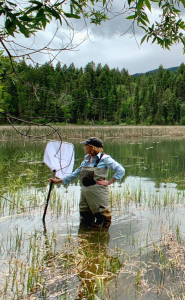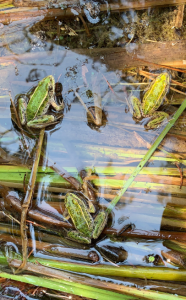The endangered northern leopard frog just got a big leap towards recovery!
August 18, 2022
Over the last couple of months, a team of amphibian heroes have been helping the endangered northern leopard frog rediscover its home in western Canada by releasing a total of 1,929 tadpoles into British Columbia wetlands. The Wilder Institute/Calgary Zoo (WICZ) has been working alongside other conservation organizations, governments, and zoos & aquariums to breed, translocate, and release frogs in B.C. where there is only one extant wild population of northern leopard frogs.
The northern leopard frog is found in Canada in three populations – the eastern population, the western boreal/prairie population, and the Rocky Mountain population. The Rocky Mountain population, found in B.C., is endangered. This frog plays an important role in its ecosystem acting to transfer nutrients between terrestrial and aquatic habitats. WICZ is a part of the British Columbia Northern Leopard Frog Recovery Team and is working alongside 13+ collaborators to save this frog.
A three-pronged approach
 Relocating thousands of tiny tadpoles is no easy task. That’s why this recovery program utilizes multiple conservation translocation methods which allows for the greatest number of tadpoles to be released into the wild. From egg to tadpole to frog, this species has the support of experts throughout every step of their life cycle.
Relocating thousands of tiny tadpoles is no easy task. That’s why this recovery program utilizes multiple conservation translocation methods which allows for the greatest number of tadpoles to be released into the wild. From egg to tadpole to frog, this species has the support of experts throughout every step of their life cycle.
Starting in early spring, biologists listen for male frogs in the Creston Valley Wildlife Management Area, where the last remaining population of northern leopard frogs exist in B.C. The deep chuckles and grunts of the calling males is a sign of mating, and that the population will produce eggs soon
Over several weeks, biologists will undertake surveys to locate the large egg masses produced by northern leopard frogs. Once located, they keep the egg masses secure using a fine mesh enclosure where the newly hatched tadpoles can be kept safe from predators. These tadpoles will either be released in Creston, translocated to the reintroduction site, or brought to the conservation breeding facilities to produce future eggs for reintroduction or head-started and released at the reintroduction site later in the season.
1. Wild to Wild
This year, some tadpoles from Creston were immediately moved to the release site near Kimberley on property owned & managed by the Nature Conservancy of Canada (NCC) and private landowners. This is the first time we are translocating northern leopard frogs to this site. Four separate wetlands here were selected as release sites based on habitat suitability criteria such as water depth, vegetation cover and dissolved oxygen levels in the water. Before release into these wetlands, the tadpoles are acclimated to their new homes by conducting a series of water changes in their holding containers. This ensures that differences in the water from site to site aren’t a shock to the tiny tadpoles. This year, 1,602 tadpoles were translocated using this method.
2. Head-starting
Other tadpoles were taken into care at the Edmonton Valley Zoo for a head-starting program. 327 tadpoles were cared for over approximately three weeks in a controlled environment where they were kept safe from predators and received the nutrition needed to develop a healthy body condition. This allowed the tadpoles to grow bigger and be released with a better chance of survival. Some individuals were also held back to help produce tadpoles for release in future years.
3. Conservation breeding to wild
Conservation breeding involves a carefully managed conservation breeding population under the care of animal care experts. Once established, conservation breeding programs can contribute genetically diverse individuals to the wild. Through this program, male and female frogs are safely stimulated to reproduce. The WICZ, Vancouver Aquarium, and Edmonton Valley Zoo have hosted conservation breeding programs for the northern leopard frog since 2017, 2009, and 2020 respectively. The WICZ’s breeding program was designed to closely replicate wild conditions while encouraging natural behaviours such as breeding. In addition to encouraging natural breeding, the team will offer hormone support and has seen frogs respond to this method with eggs produced in the past. WICZ’s new state-of-the-art conservation facility, the Archibald Biodiversity Centre which recently opened this summer, will allow for even more space for the team to continue breeding efforts.
What comes next?

Throughout the months of July through September, WICZ researchers will monitor the released frogs every week to see how they are adapting to their new home near Kimberley, B.C. During this time, the tadpoles will undergo metamorphosis, transforming into froglets and eventually become adults. In the spring, researchers will return to see if frogs have successfully overwintered and are breeding. Each frog has a unique spot pattern which will help researchers identify them and better understand how many of the released tadpoles are successfully entering the next stage in their life cycle, with the hopes that they will eventually contribute new tadpoles to the population. In a recent weekly monitoring survey, researchers observed 109 young-of-year northern leopard frogs. This is over 3X as many as we have found during weekly surveys conducted at the same time of year at a previous reintroduction site. The team is excited about these promising numbers found at the Kimberley reintroduction site.
To learn more about our northern leopard frog conservation program, head over to: https://wilderinstitute.org/conservation/northern-leopard-frog/
The Wilder Institute/Calgary Zoo is proud to collaborate with the British Columbia Northern Leopard Frog Recovery Team, B.C. Ministry of Land, Water and Resource Stewardship and Ministry of Forests, Creston Valley Wildlife Management Area, Edmonton Valley Zoo, Fish and Wildlife Compensation Program, Nature Conservancy of Canada, and Vancouver Aquarium. The success of this critical program would not have been possible without their continued support.
What else is happening in the world of wildlife conservation?
